In this HubSpot review, I’ll cover what’s easily one of the most popular CRMs on the market today and one of my top choices of best free CRM. I’ll explore its pros and cons, pricing, key features, reputation, and how it compares to leading HubSpot alternatives — because although it does a lot right, the price points of the higher tiers is one of the few reasons it’s not the best CRM system for every business.
What Is HubSpot?
Another attractive quality of HubSpot is its generous free plan, providing users with an organized way to manage contacts at zero cost. If you find you outgrow the limitations of the free plan, there are many options to upgrade to the Marketing, Sales, or Service Hubs to enjoy the full range of features. Depending on which hub you choose, you can benefit from sales pipeline tracking, marketing automation, and lead generation.
HubSpot CRM Pricing
HubSpot offers a large array of plans under different hubs. The Sales Hub has four plans, including a very feature-rich, well-rounded free plan.
Here’s an overview of how each of these plans compare:
| Free | Starter | Professional | Enterprise | |
| Starting Price | $0 | $15/user/month | $90/user/month | $150/user/month |
| User Limit | 5 | N/A | N/A | N/A |
| Free Version | Free plan | 30 day trial | 30 day trial | 30 day trial |
| Conversational Bots | Limited | Limited | Advanced | Advanced |
| Email Scheduling | ✅ | ✅ | ✅ | ✅ |
| HubSpot Phone Numbers | ❌ | 1 | 3 | 5 |
| Multiple Currencies | ❌ | 5 | 30 | 200 |
| Calling | ❌ | 500 minutes | 3,000 minutes | 12,000 minutes |
| Team Email | ✅ | ✅ | ✅ | ✅ |
| Shared Inboxes | 1 | 1 | 100 | 200 |
| Support | ❌ | Email, in-app chat support | Email, in-app chat, phone support | Email, in-app chat, phone support |
HubSpot’s Key Features
Given that HubSpot is one of the best CRM services, it offers a range of strong features worth showcasing. Here are some of the key features Ifound noteworthy to cover here:
Lead Management and Prospecting
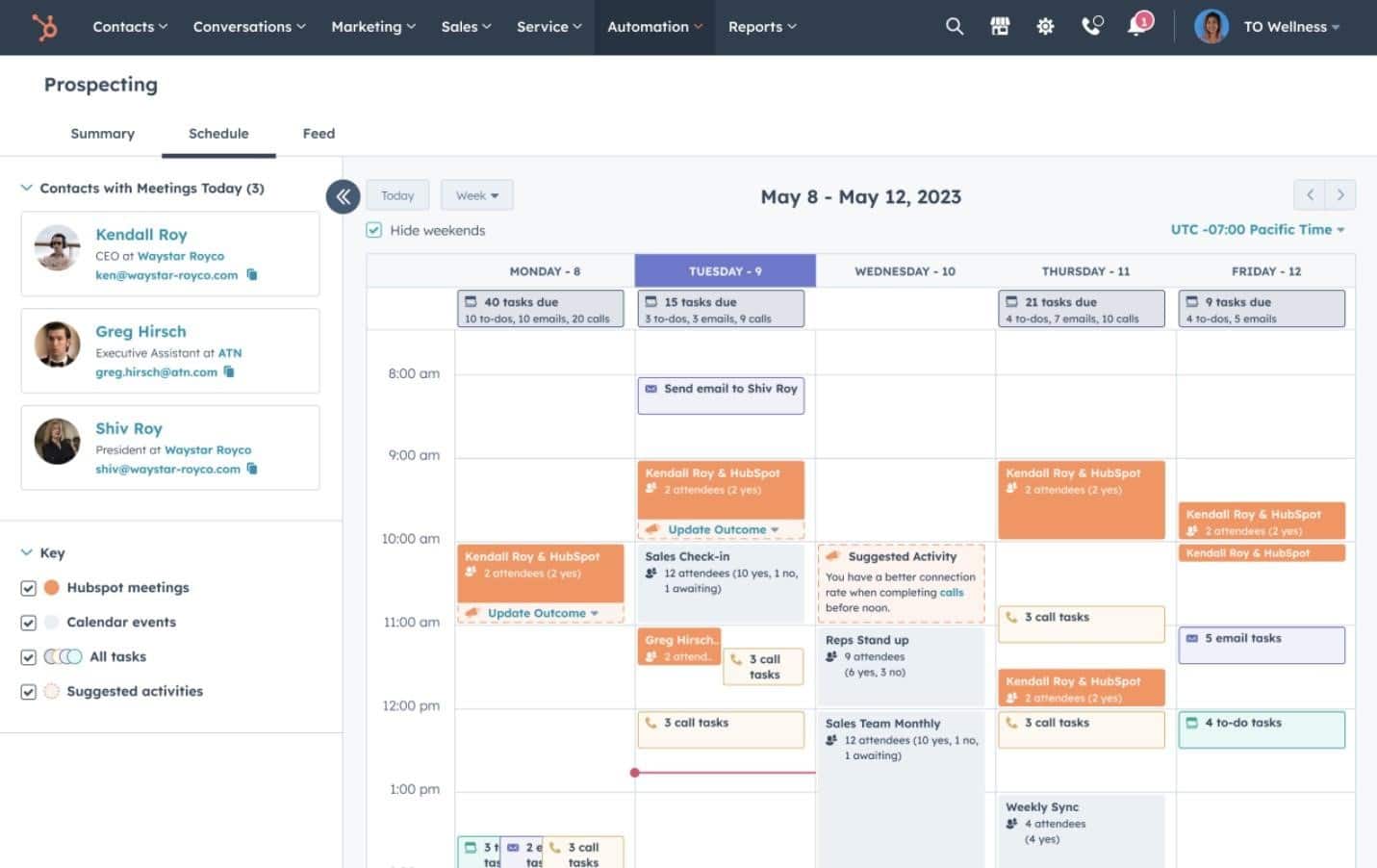
HubSpot offers incredibly robust lead management features. For example, it’ll automatically move leads through your pipeline as your sales team engages with them.
This frees up your sales rep to focus on selling while managers can view live reports on their progress. The prospecting workspace feature is another excellent tool for helping reps:
- Stay organized
- Optimize their schedule, and
- Prioritize tasks
It makes it even easier for team leads and managers to schedule meetings, keep track of each sales rep, and see the progress of leads through the customer journey.
Deal Pipelines
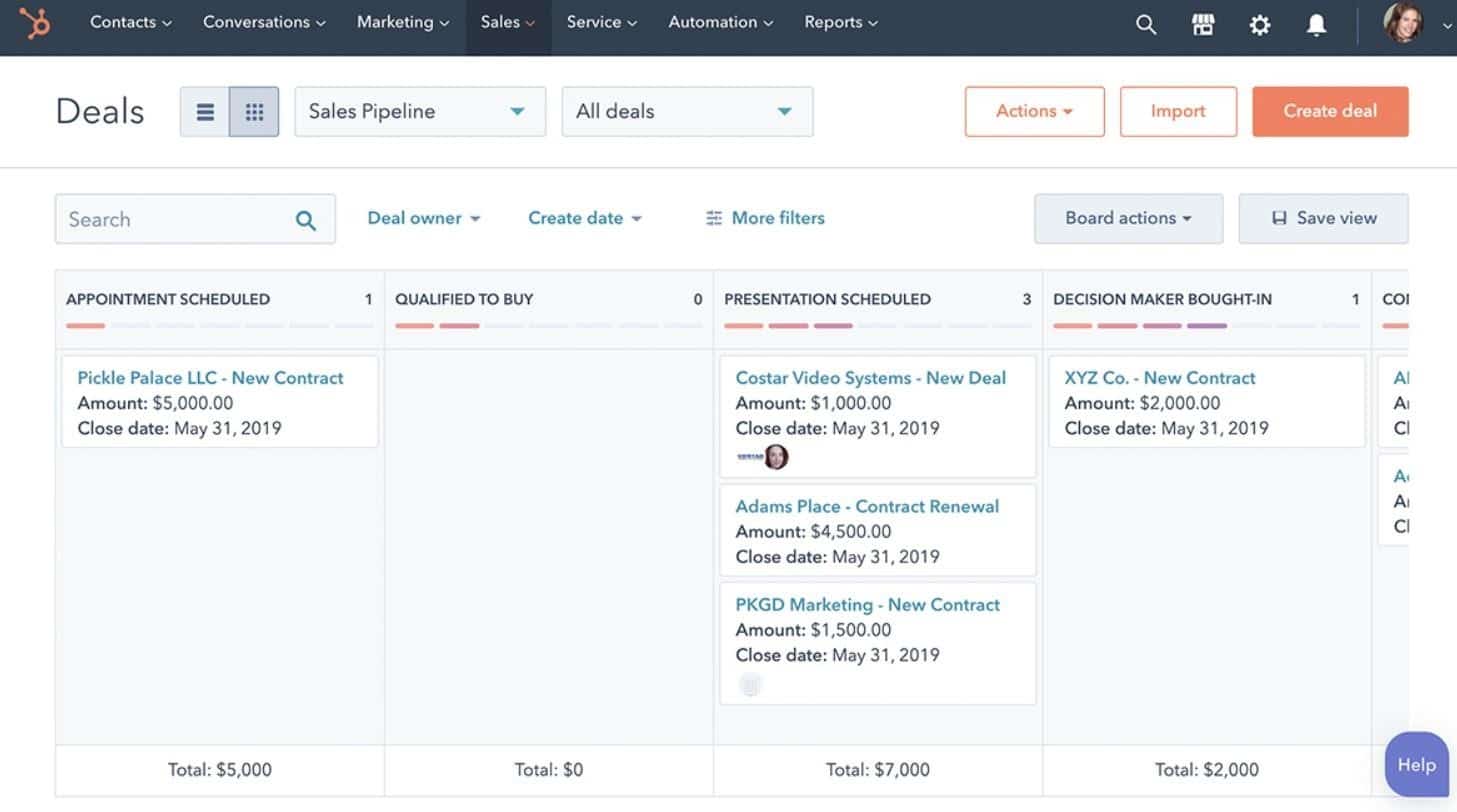
HubSpot’s deal pipelines make it easier to streamline managing your business deals. Although other CRM platforms also offer this feature, I found HubSpot’s ease of use really makes it stand out.
The platform makes it very straightforward to assign tasks, add deals, and track prospects all in one place. Plus, its simple drag-and-drop editor makes customizing the pipeline a whole lot simpler.
Beyond this, it’ll automatically update your contact and company records, so you can eliminate manual data entry and reduce the chances of errors in your CRM database.
However, as I mentioned earlier, unlike some competitors like Salesforce and Zoho CRM, for example, HubSpot limits the number of pipelines you can create, even on its top-tier plan.
Email Templates and Tracking

Crafting the perfect sales email can be time-consuming, and doing multiple for different prospects can take up your entire week. For this, HubSpot offers pre-designed layouts and a user-friendly UI.
In fact, depending on your plan, HubSpot offers up to 5,000 email templates, hence why it’s known for being one of the best CRMs for email marketing. You can customize these templates, of course.
Simply add relevant sales documents, personalization tokens, or meeting links, for example. What’s more, you can also track your sales outreach using HubSpot’s email tracking tool.
It’ll notify you when prospects click on the link or open your email, so you can build a compelling CRM database of all your leads.
HubSpot AI Tools and Content Assistant

HubSpot’s AI-powered assistants work with existing customer support, marketing, and sales tools, making creating and sharing content within HubSpot’s ecosystem more plug-and-play than ever.
The generative content assistant also has internal uses. When creating performance reports, HubSpot’s AI content summarizer can reduce large data sets into readable and easily accessible descriptions, eliminating manual data collection and interpretation.
It’s not just text you can generate with HubSpot AI – you’re also getting a free AI website generator that lets you create a personalized website that represents your brand. That said, functions like AI lead scoring are missing.
Beyond this, HubSpot doesn’t offer AI buyer assistance and deal insights, either — which is available with Salesforce, for example, but again, this does come at a high price of $330/user/month.
Whether the functionality is enough is up to you to decide, but overall, I found HubSpot offered more than enough for most mid-sized businesses at a fraction of the cost of some rivals.
Sales Analytics and Reporting

HubSpot offers customizable reports with detailed sales analytics for real-time updates on your team performance, pipeline, prospecting touches, deal status changes, and conversions, for example.
The custom report builder lets you report on any cross-object or single-object data within your CRM. Cross-object reporting allows you to build and run custom reports across various:
- Data sets
- Pipelines
- Events, and
- Funnels
Let’s say you want to view the number of leads generated, opportunities created, and tasks finished by one particular sales rep in a single report, you can do so through cross-object reporting.
I found the reporting feature is easy to use and will help you prioritize sales efforts with real-time deal data, extract insights quickly, and identify new opportunities with waterfall reporting.
Meeting Scheduling
In the most recent update in July 2024, HubSpot now enables you to set up a rolling availability for up to a year in advance. This enhancement allows your customers and prospects to easily schedule recurring appointments with you, extending beyond the previous maximum of 11 weeks.
HubSpot Integrations
Plus, although not unique, I liked how HubSpot categorizes the integrations into marketing, workflow, finance, and productivity, for example, making it easier for you to explore the marketplace.
Overall, this is an excellent catalog when compared to competitors like Monday CRM and Agile, for example, which offer 200+ and 40+ integrations, respectively.
HubSpot only really falls behind Salesforce’s 3,000+ integrations, which, obviously comes at a cost higher than HubSpot.
What is HubSpot Good for?
This is because it comes with a great entry-level plan at $15 per user per month. That said, it’s also a great option for larger B2B or B2C businesses.
However, if you’re a growing business, HubSpot isn’t the best option. Although more affordable than Salesforce, HubSpot’s highest plan still costs $150/user/month.
For this, I recommend a platform like Zoho CRM, which offers its best plan at just $52/user/month.
HubSpot vs Top Competitors
Still unsure whether HubSpot is best for your business? Here’s an overview of how it compares to the best HubSpot alternatives on the market in 2024:
| CRM Platform | HubSpot | Salesforce | Monday CRM | Pipedrive | Act! | Zoho |
| Best For | Any-sized business | Large organizations | Small businesses | Pipeline management | SMB needs | AI-powered assistance |
| Starting Price | $15/user/month | $25/user/month | $12/user/month | $14/user/month | $30/user/month | $14/user/ month |
| Free Version | Free plan | 30-day trial | 14-day trial | 14-day trial | 14-day trial | 15-day trial |
| Compatibility | Android, iOS, Mac, Web | iOS, Android, Web | iOS, Android, Web | iOS, Android, Web | iOS, Android, Web | Android, iOS, Web |
| Top 3 Features | Lead management, conversation intelligence, revenue tracking | 3,000+ integrations, 24/7 phone support, AI automation | Unlimited free viewers, 200+ templates, mass email tracking | Contact mapping, world-class storage, meeting scheduler | Built-in SMS, audience segmentation, automated workflows | Predictive sales, omnichannel presence, journey orchestration |
HubSpot vs. Salesforce
As Iexplored in my Salesforce review, it’s best suited for growing businesses looking for a scalable CRM – and it’s great for businesses that want to offer top-notch customer service to their customers.
On the other hand, HubSpot is perfect for businesses looking for an entry-level CRM solution to get started. Although it has more features, Salesforce‘s basic plan is pricier than HubSpot’s.
However, another factor to consider is that the price increase between Salesforce’s Starter and Professional packages isn’t as steep as HubSpot’s. For instance:
- Salesforce’s price jumps from $25/month to $100/month
- HubSpot’s price increases from $15/month to $90/month
The jump with HubSpot equates to 500%. That said, unlike Salesforce, HubSpot offers ample free tools for startups, including deal pipelines, team emailing, and 5,000 email templates.
HubSpot vs Zoho
Starting at $14/month, Zoho is a more affordable option. However, HubSpot offers more advanced features such as Stripe integration, deal tags, e-signatures, and e-mail health reporting.
Both offer a free plan, though. That said, if you’re looking for automation, Zoho is a better option, as it includes 2,500 workflow rules. HubSpot doesn’t offer automation in its free package.
All in all, Zoho is ideal for small businesses looking for an affordable tool. However, if you want comprehensive marketing tools, such as predictive lead scoring, choose HubSpot.
Related: A Full Zoho CRM Review for 2024
HubSpot vs Pipedrive
Pipedrive fits the bill for small and mid-sized businesses that can’t rely on a free CRM. It offers more affordable upgrades compared to HubSpot and allows you to enable/disable the add-ons as needed.
Pipedrive focuses mainly on solving sales problems and will help you effectively manage your sales pipeline and contacts at an unbeatable price. The Pro plan costs just $49/user/month.
To compare, HubSpot’s Pro plan costs $90/user/month. That said, HubSpot is a great choice if you want to try various tools for free or if you’re a large business with:
- Substantial data
- Intricate procedures
- Requirements spanning various departments
HubSpot Customer Reviews
HubSpot has received a lot of positive reviews for its comprehensive set of sales, marketing, and customer service tools. On TrustRadius, for example, it’s rated 8.5/10 based on 4,453 reviews.
Many appreciate how its multi-functional nature helps in managing different business tasks. Others highlight how robust the platform and automations are.

Of course, the free plan is another huge USP highlighted by many HubSpot reviews online. There’s so much positive feedback you’ll find, even related to its support and interface.
No tool is perfect, though. Among the complaints is the price point, which is a given, but some also had differing opinions on user-friendliness. Occasional glitches are another.
Overall, as I found with my Monday CRM review or with Salesforce, for example, HubSpot has a solid reputation for being one of the best CRMs. It all depends on your needs and budget.
How to Use HubSpot – Quick Guide
In this walkthrough, I’ll demonstrate the first few steps in setting up your CRM system with HubSpot. Setting up a fully functional system takes more time and steps than I can cover here, but you’ll be able to get a feel for the interface.
Step 1: Enter your company details
When you sign up with HubSpot, you’ll be guided through a number of steps where you can specify your purpose for using HubSpot. It’ll ask for your company name, industry, size, and your prior experience with CRM to inform the type of onboarding you’ll receive and which trial version is best for you.
Step 2: Follow the trial guide
After signing up, you’ll be met with the following guide to assist you through the process of setting up your HubSpot CRM. It’ll walk you through essential steps such as adding your teammates and contacts and finding relevant integrations to complete your system.
Step 3: Add contacts to your CRM
First thing first, let’s start migrating your address book over to HubSpot. As you can see below, you’ll be able to view your contacts in a spreadsheet-style database with fully customizable columns.
You can also filter and order them based on different criteria, such as last activity or lead status. To start adding your own contacts, click the ‘Import’ button in the top-right corner.
Step 4: Upload 'Contacts' file
Once you’ve clicked ‘Import’, you’ll be able to choose whether you import an existing file, or sync between two systems. I chose the former since my contacts were in a spreadsheet.
While I uploaded contacts, you can also upload deals, products, companies, or tickets at this stage, depending on what sort of data you want to organize. You can then upload your file. Files should be in CSV, XLS, or XLSX format to import successfully.
Step 5: View your contacts
After successfully importing your contacts, you should be able to view the populated database with all your familiar customers.
You can click the ‘Preview’ button to bring up essential information about them in the sidebar, including phone number, email, and last contacted date, and also perform actions like adding task reminders, contacting them, or scheduling a meeting.
Step 6: Add individual contacts
Once you’ve migrated your existing contacts to HubSpot, you don’t have to do that every time you add a new customer. To add a new individual contact, you simply click the ‘Create Contact’ button right next to the ‘Import’ button shown in step 3. You can then quickly fill out the relevant fields to add them to your contact records.
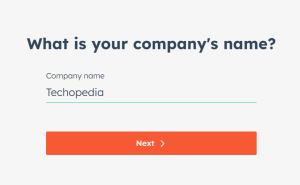
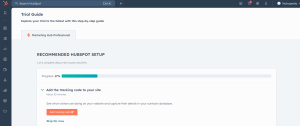


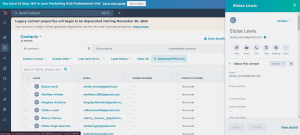

We base our recommendations on first-hand testing. All the CRM Software products we feature, have been tested based on the following criteria:How We Review And Test CRM Software
Verdict – Is HubSpot Worth it?
HubSpot is worth it when you consider the extensive features it offers. You get ample for free, including email tracking and scheduling and even Slack integration — which is rare.
HubSpot’s higher-end plans are also among the very best for large businesses, but it’s expensive, especially when there are more affordable top-tier plans offered by rivals, including Salesforce.
We base our recommendations on first-hand testing. All the CRM Software products we feature, have been tested based on the following criteria:How We Review And Test CRM Software
How to Choose the Best CRM Solution
Let’s look into some of the key factors you should consider before choosing the best CRM app for your business:
Set a budget and see whether the plan includes everything you need within this range. This is important as some features may be reserved for higher-end plans.
Start by listing all the features your business will need and choose CRM software according to your industry. Look for common features like lead management, contact management, customer service management, and sales forecasting.
Scalability is important to consider. How much would it cost to scale with the CRM you’ve chosen? Does it include all the features you’d need at this point?
A user-friendly interface will reduce the training period and learning curve for your team. Ideally, pick software that can be set up within a few minutes and one that fits with your team’s technical expertise. Be sure to make use of any free versions to test this.
Check whether the CRM integrates with the tools your business uses. This will ensure consistency and efficiency. Also, make sure the integrations aren’t limited to higher-tier plans.
Consider the customer support hours, available channels, and responsiveness. Always choose a reputable provider to ensure minimal issues and prompt support.
FAQs
What is the disadvantage of HubSpot?
What is HubSpot mainly used for?
Is HubSpot free and legit?
Is HubSpot CRM expensive?
References
- What is Customer Journey Map? (MIU City University)
- What Is Predictive Analytics and Why Is It Important? (University of Maryland)
- How to Choose the Right Forecasting Technique (Harvard Business Review)





